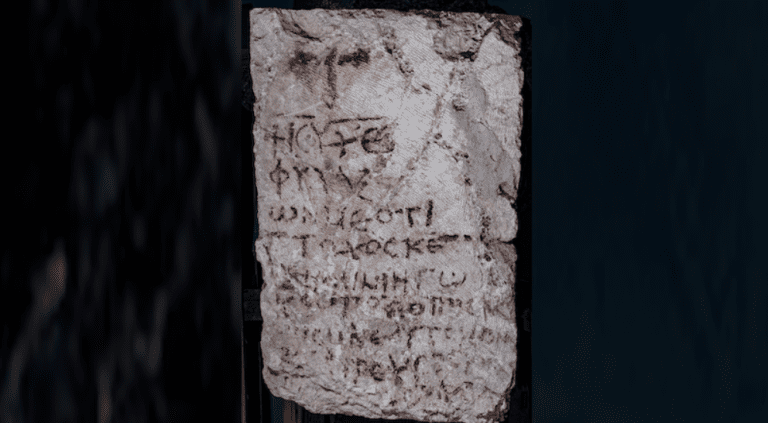
Hebrew University archeologists excavating at the Hyrcania Fortress in the Judean Desert recently discovered a rare inscription of Psalm 86 on the side of a building stone. It reads, “Jesus Christ, guard me, for I am poor and needy. Guard my life, for I am faithful to You.” The adapted words of King David’s original Hebrew Psalm are painted in red letters on the side of a large building stone underneath a cross.
The inscription of Psalm 86 is one of the few Koine Greek Psalm inscriptions ever found on rock instead of parchment paper. It’s inscribed in the same Greek the New Testament of the Bible was recorded in. According to The Times of Israel, a 5th-century CE community of Byzantine Christian monks is suspected to have left the inscription behind.
Dr. Avner Ecker of Bar-Ilan University noted, “The priest was not a native Greek speaker, but likely someone from the region who was raised speaking a Semitic language.” A small gold ring with a turquoise stone-like hailing from Persia was discovered alongside the stone marking of the Psalm. “Mashallah,” God has willed it, was inscribed on the ring, which dates back to the 7th-8th century.
The 2023 Hyrcania excavation was directed by Dr. Oren Gutfeld and Michal Haber of the Hebrew University, in conjunction with Carson-Newman University (Tennessee) and American Veterans Archaeological Recovery, a program that uses archaeology to help US armed forces veterans transition back to civilian life.
According to The Times of Israel, Hebrew University archeologists discovered the piece at the Second Temple-era structure, located 17 kilometers Southeast of Jerusalem. The fortress’s ruins remain primarily untouched. It was refurbished by King Herod and later occupied by a Byzantine Christian monastery from the 5th to 9th century. During that time, the monastery was called Kastellion, or “Little Castle.”
Gutfeld told The Times of Israel he had an “Indiana Jones moment” exploring stepped tunnels, first discovered in 1960 by a British scholar, at the base of the hill 120 and 80 meters below the surface. Haber also noted that they are theorized to have possibly been a slave labor project for King Herod’s enemies. The university said the pilot dig, which took place earlier this year, was the first “methodological, academic archaeological excavation” undertaken at the site.
Previously, the site had a few short visits by European archaeologists, the last of note being in the 1950s when a Belgian archaeologist, after being led to the site by Bedouins, discovered a trove of papyrus documents. Jordan controlled the area at the time. The Israeli Antiquities Authority, in conjunction with the Civil Administration of Judea and Samaria, has in recent years launched an ambitious project to map, explore and secure the myriad archaeological sites strewn about the Judean Desert. The Hyrcania Fortress falls under this aegis.
Haber and Gutfield said in a statement, “We are aware that our excavations will draw the attention of looters. The problem persists; it was here before us and will likely continue after us, underscoring the need for academic excavation – particularly in such a sensitive site as Hyrcania, though this is just one example. We are simply trying to stay a few steps ahead.” Another four-week excavation is planned for 2024.
